Abstract
1. This study compares the activity of BMS-180560 (2-butyl-1-chloro-1-[[1-[2-(2H-tetrazol-5-yl)phenyl]-1H-indol-4- yl]methyl]-1H-imidazole-5-carboxylic acid), an insurmountable angiotensin II (AII) receptor antagonist, with that of losartan and EXP3174 in functional and biochemical models of AII-receptor activation. 2. BMS-180560 selectively inhibited [125I]-Sar1Ile8AII ([125I]SI-AII) binding to rat aortic smooth muscle (RASM) cell and rat adrenal cortical AT1 receptors (Ki = 7.6 +/- 1.2 and 18.4 +/- 3.9 nM respectively) compared to adrenal cortical AT2 receptors (Ki = 37.6 +/- 1.3 microM). The Ki values of BMS-180560 and EXP3174, but not losartan, varied as a function of the BSA concentration used in the assays, indicating that the diacid drugs bound to albumin. 3. BMS-180560 (3-300 nM) increased the KD of SI-AII for RASM cell AT1 receptors. Only at high concentrations of BMS-180560 (300 nM) were Bmax values decreased. 4. BMS-180560 inhibited AII-stimulated contraction of rabbit aorta with a calculated KB = 0.068 +/- 0.048 nM and decreased maximal AII-stimulated contraction at 1 nM BMS-180560 by 75%. In the presence of 0.1% BSA, a higher KB value (5.2 +/- 0.92 nM) was obtained. Losartan behaved as a competitive antagonist with a KB = 2.6 +/- 0.13 nM. Contraction stimulated by endothelin-1, noradrenaline, KCl, or the TXA2 receptor agonist U-46619 were unaffected by BMS-180560 (1 nM). 5. AII stimulated the acidification rates of RASM cells as measured by a Cytosensor microphysiometer with an EC50 of 18 nM. Losartan (30 nM) shifted the AII concentration-effect curves in a competitive manner whereas BMS-180560 (0.01 and 0.1 nM) decreased the maximum responses by 60 and 75% respectively. Inhibition by losartan and BMS-180560 could be reversed following washout although recovery took longer for BMS-180560. 6. In [3H]-myoinositol-labelled RASM cells, losartan (30 and 200 nM), shifted the EC50 for AII-stimulated [3H]-inositol monophosphaste formation to higher values, with no change in the maximal response. By contrast, EXP3174 (0.1 to 1 nM) decreased the maximal response in a concentration-dependent manner (17-55%). BMS-180560 (3 and 10 nM) increased the EC50 for AII and decreased the maximum response by 30 and 80% respectively. The inhibition by EXP3174 and BMS-180560 could be reversed by inclusion of losartan (200 nM) indicating that the inhibition was not irreversible.(ABSTRACT TRUNCATED AT 400 WORDS)
Full text
PDF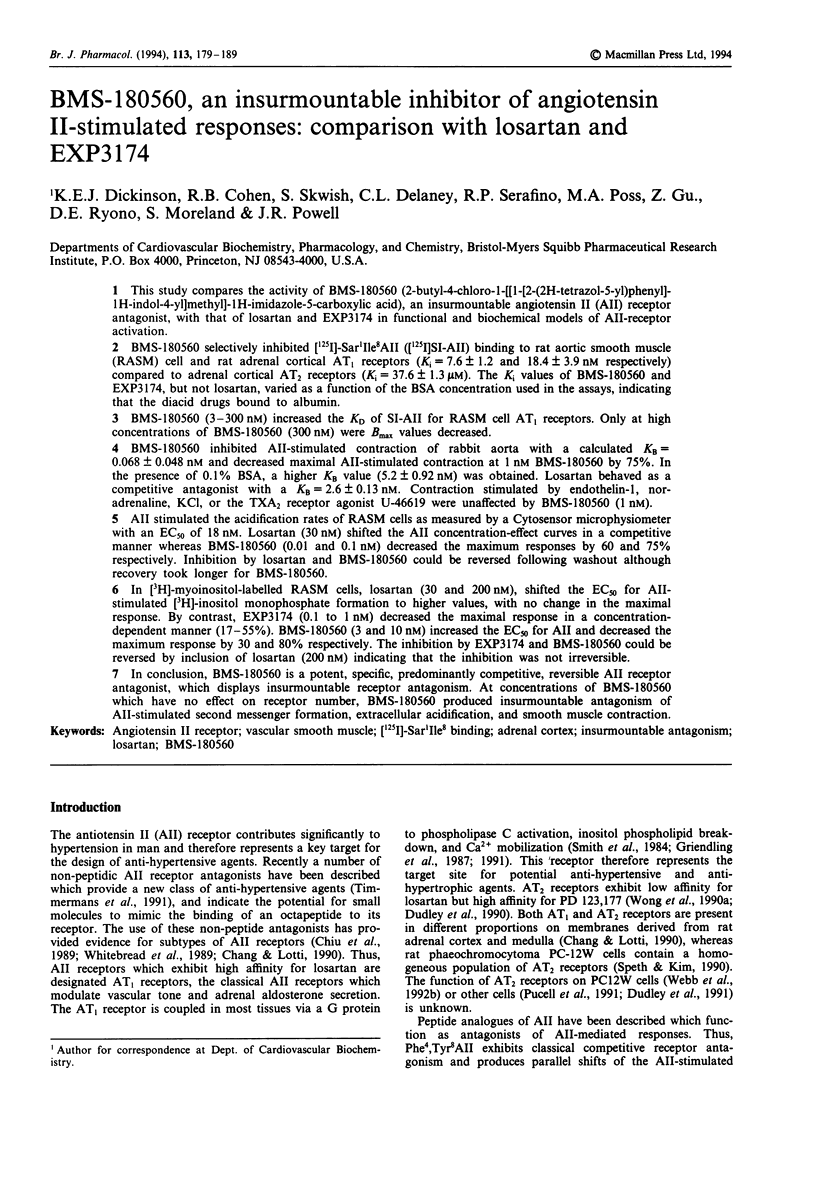
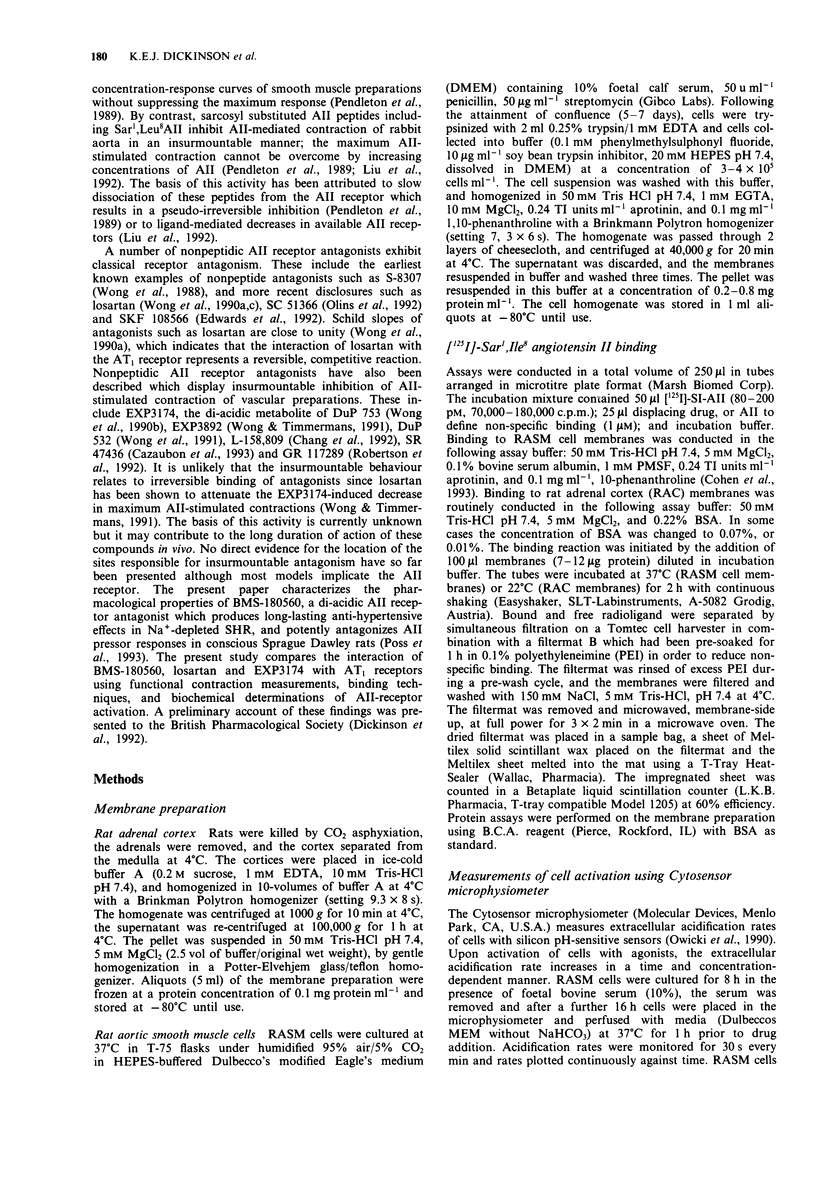
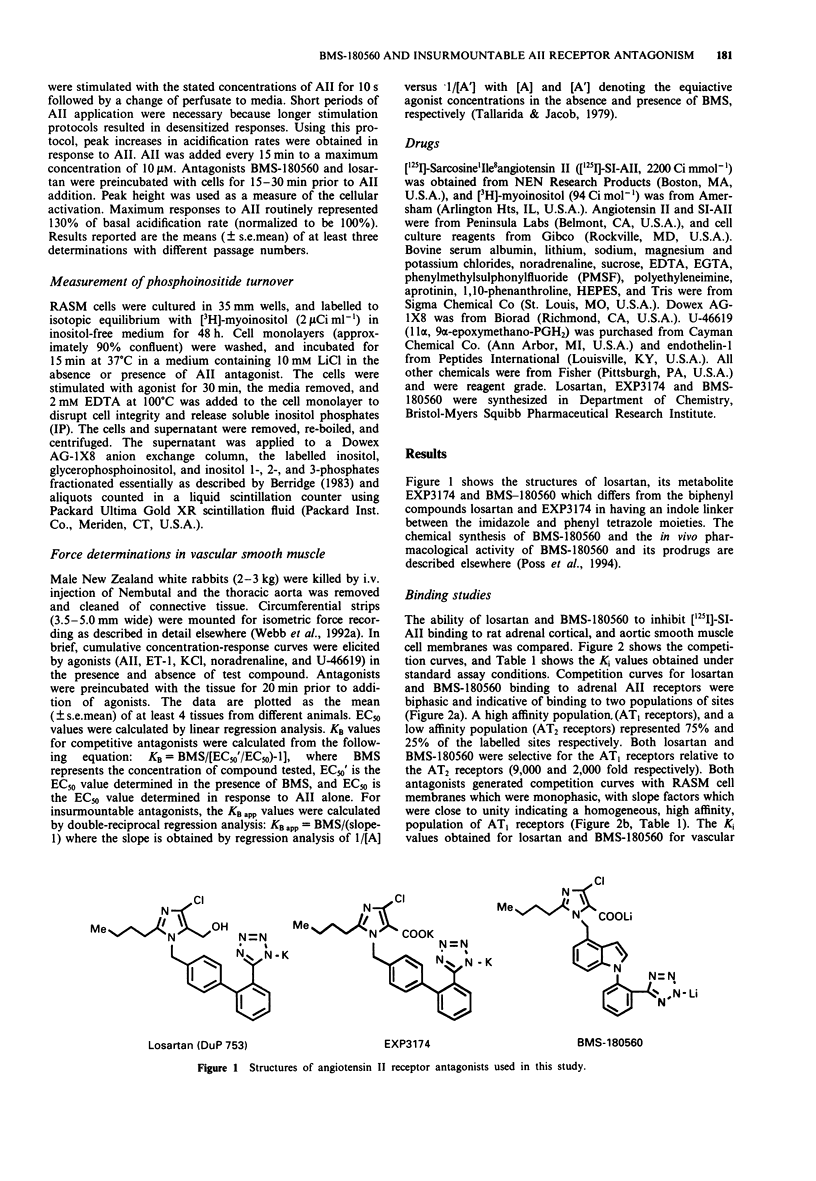
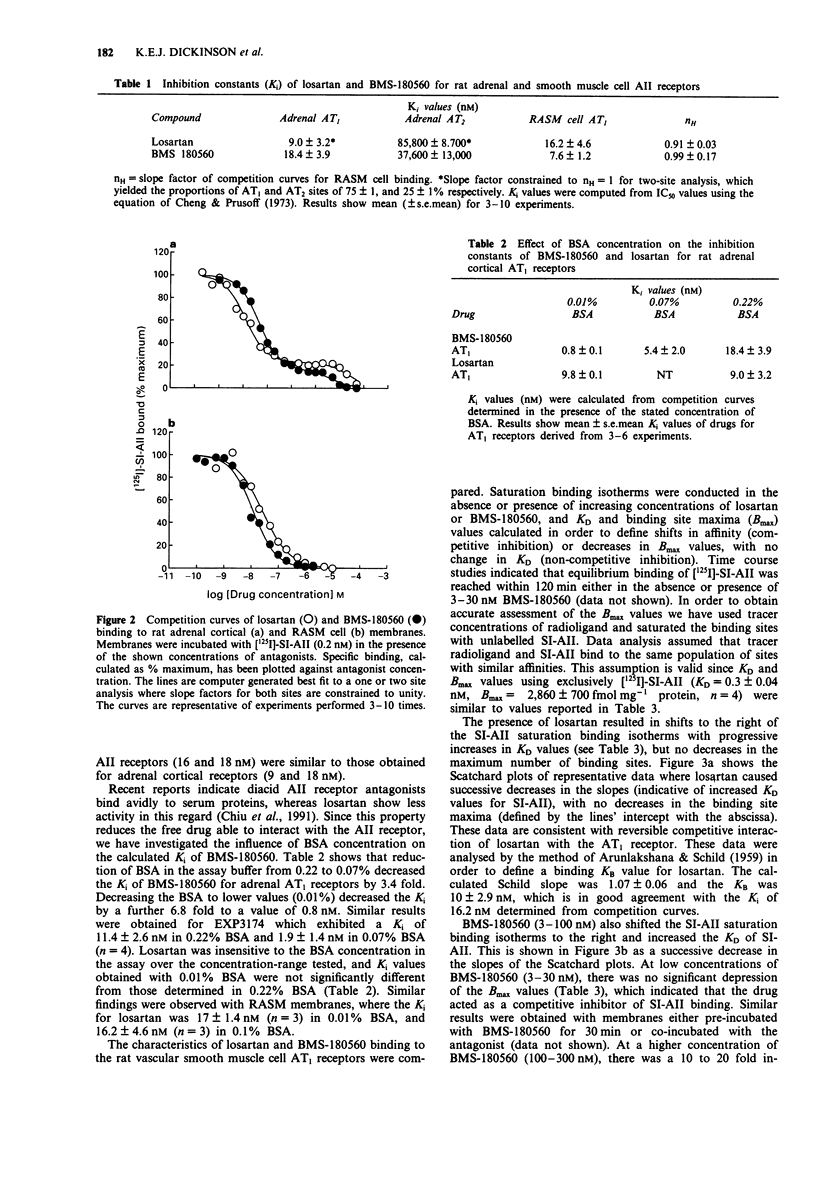
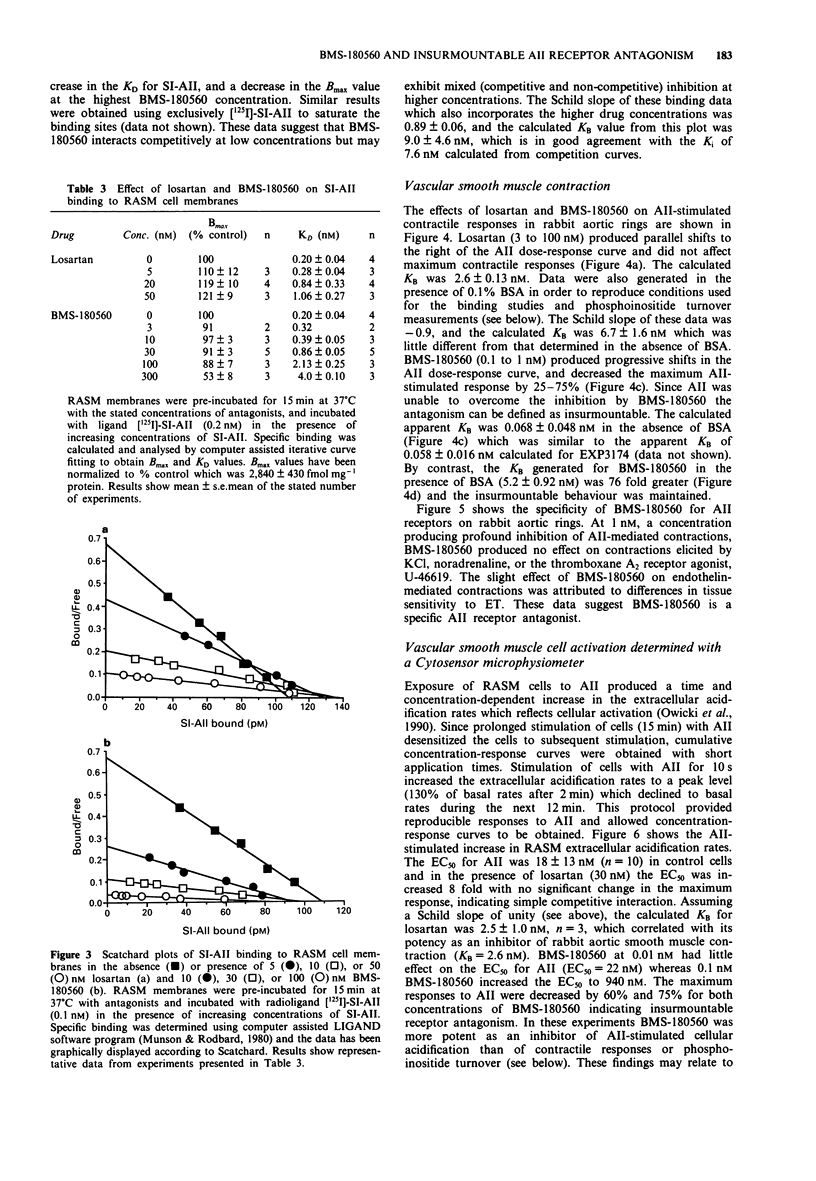
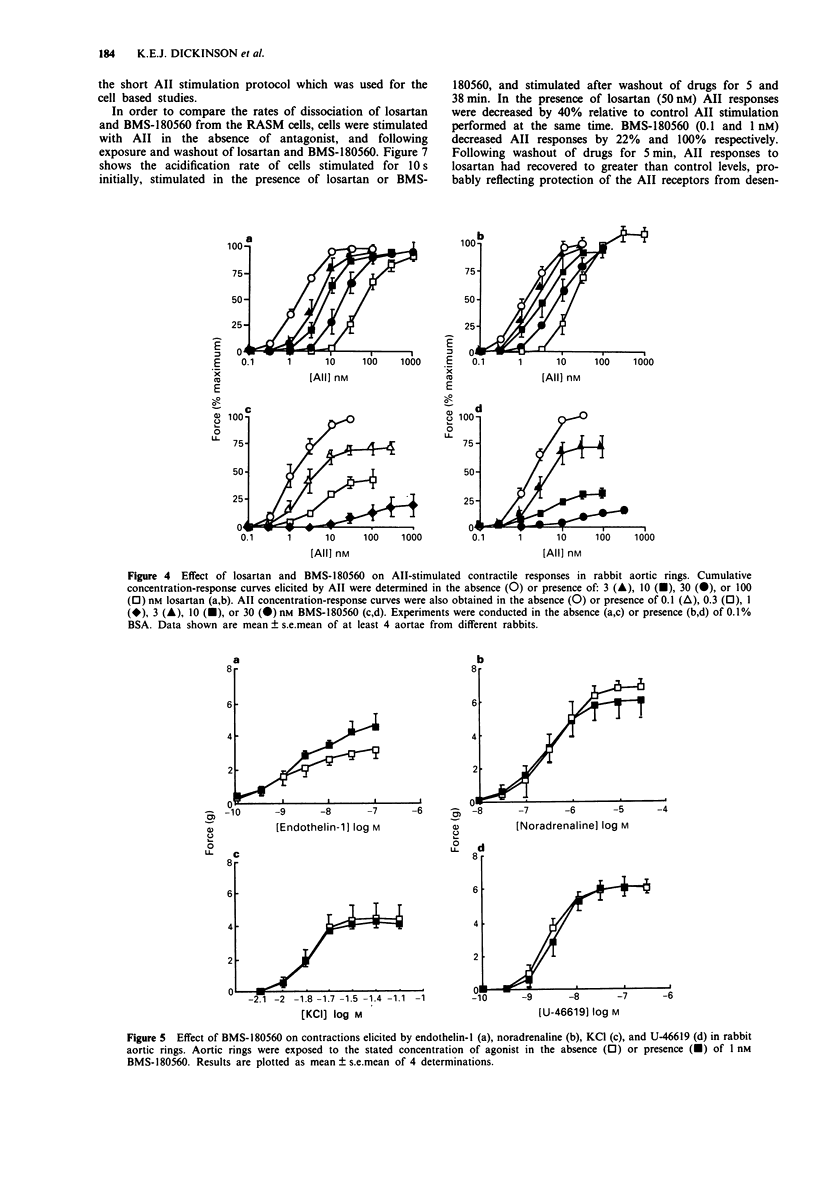
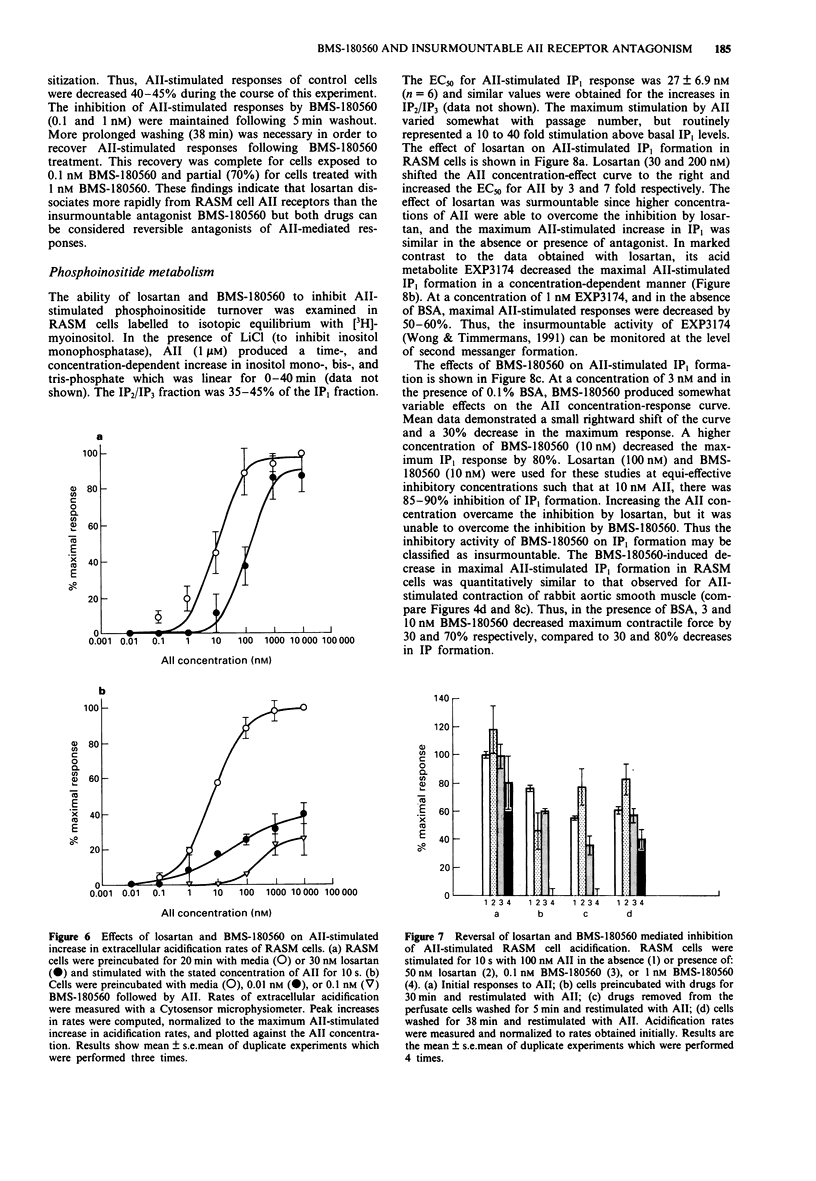
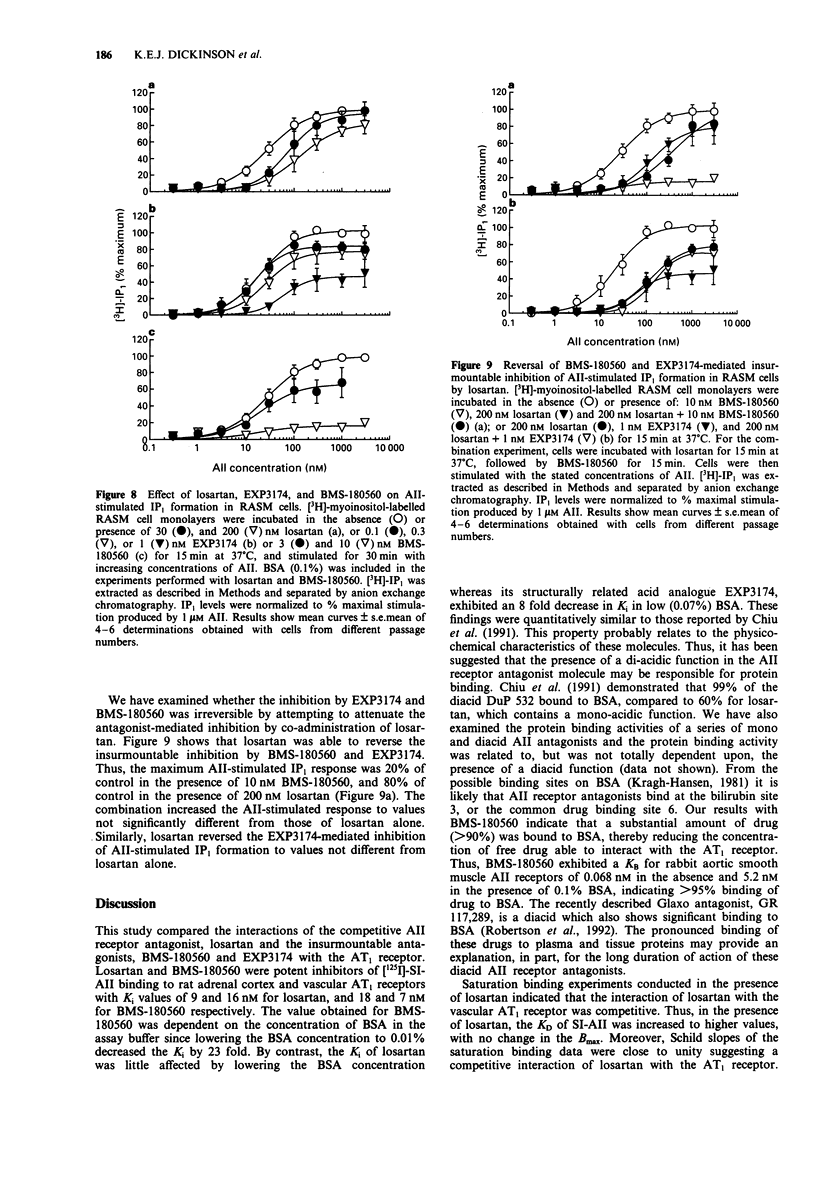
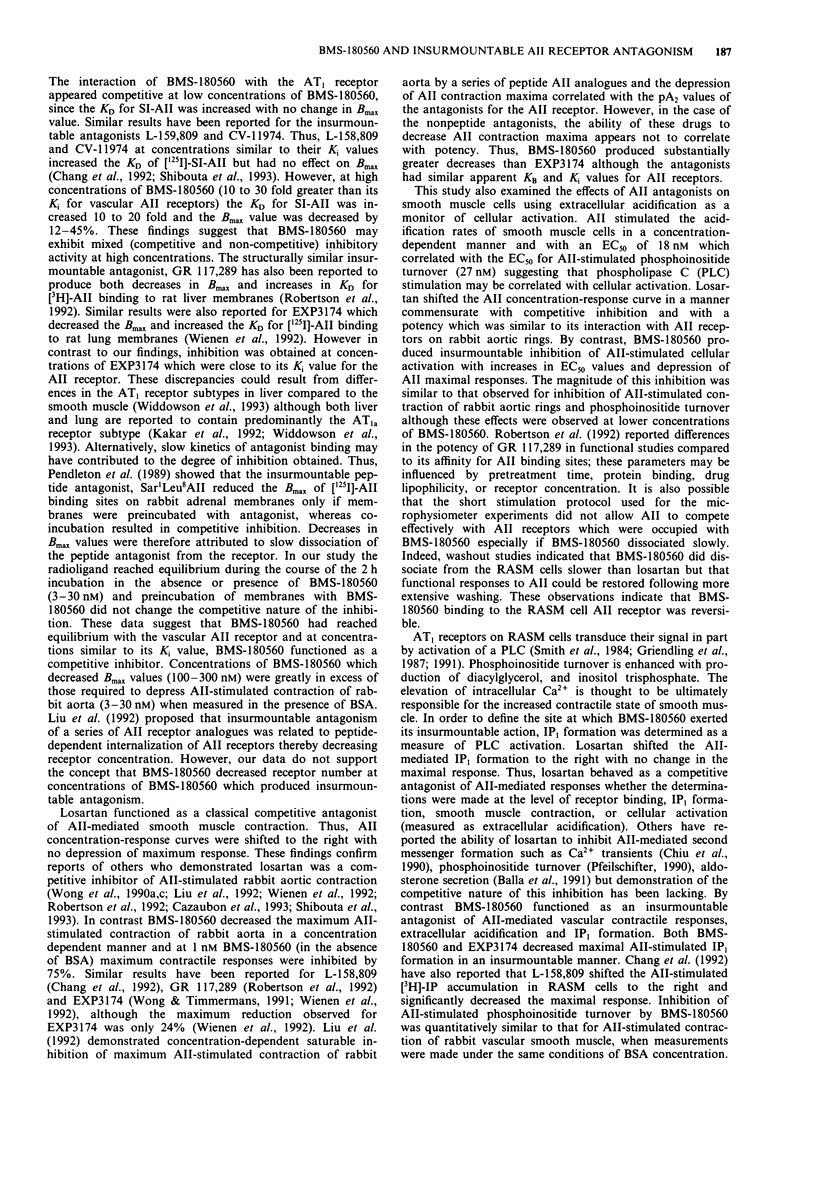
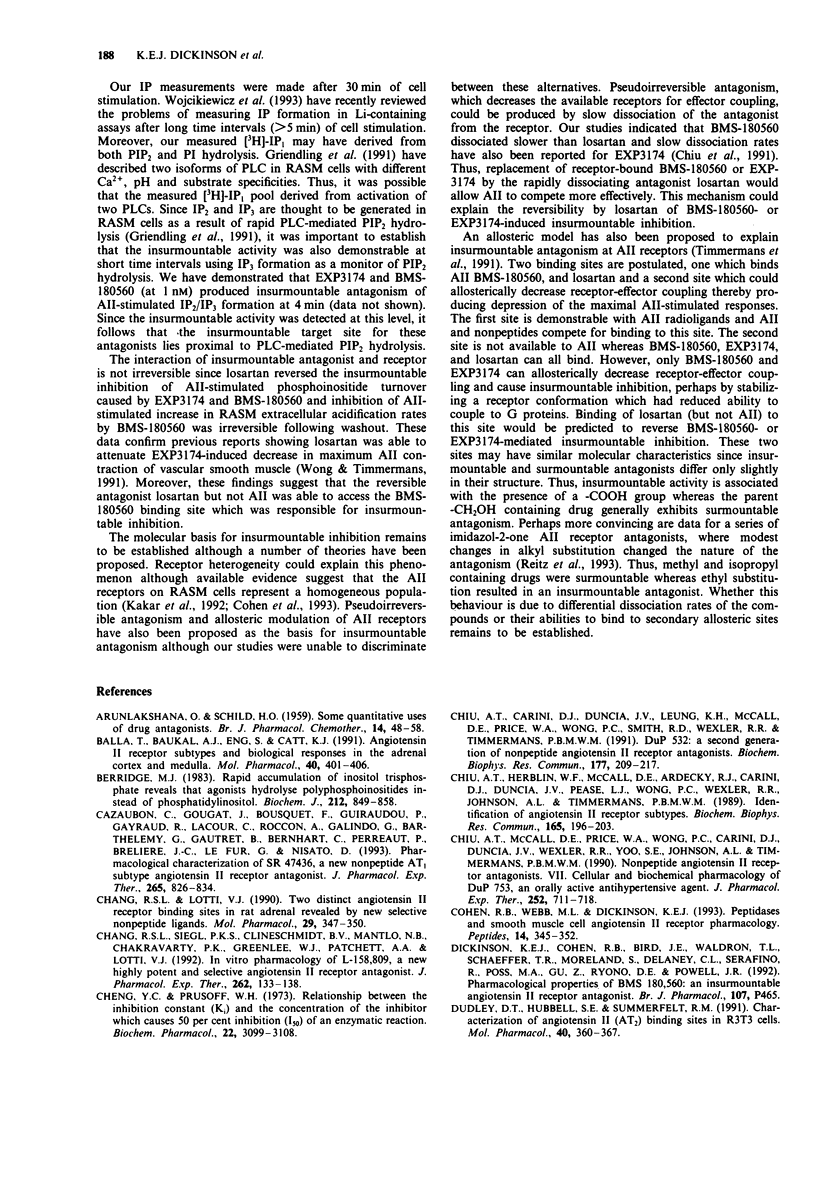
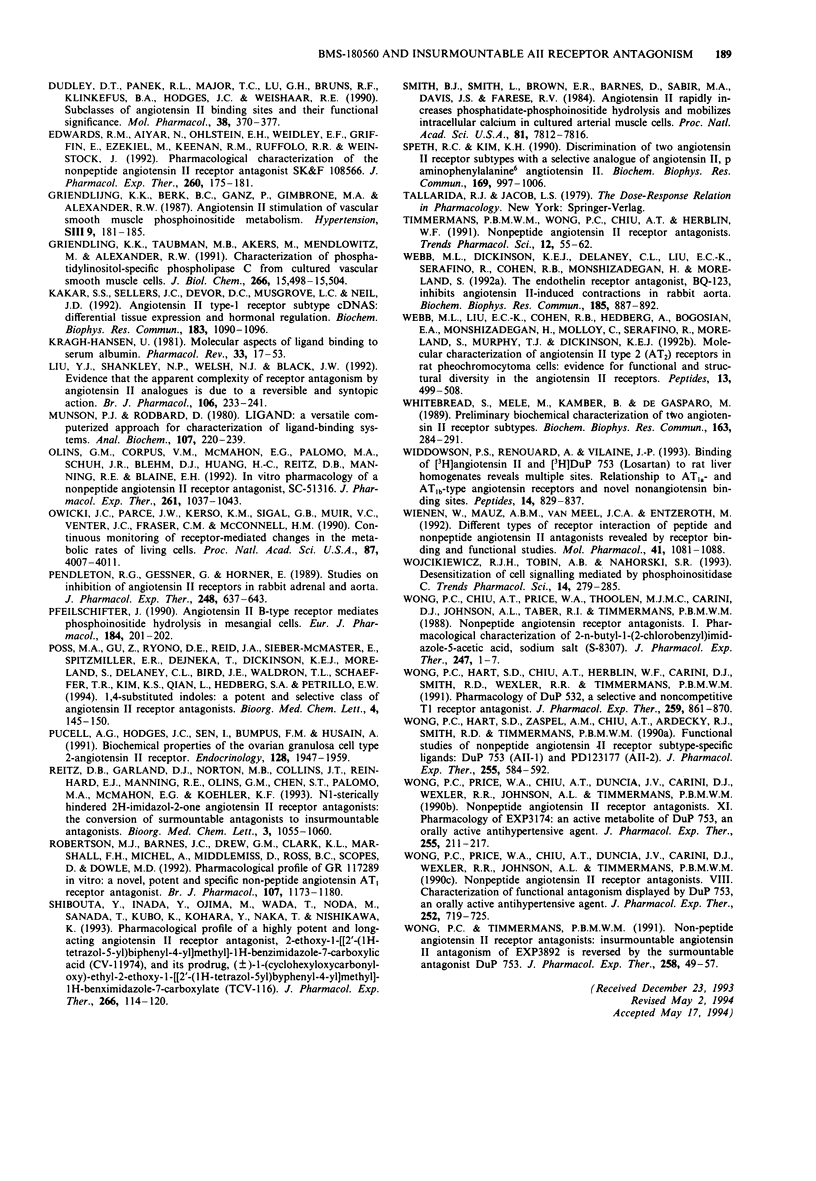
Selected References
These references are in PubMed. This may not be the complete list of references from this article.
- ARUNLAKSHANA O., SCHILD H. O. Some quantitative uses of drug antagonists. Br J Pharmacol Chemother. 1959 Mar;14(1):48–58. doi: 10.1111/j.1476-5381.1959.tb00928.x. [DOI] [PMC free article] [PubMed] [Google Scholar]
- Balla T., Baukal A. J., Eng S., Catt K. J. Angiotensin II receptor subtypes and biological responses in the adrenal cortex and medulla. Mol Pharmacol. 1991 Sep;40(3):401–406. [PubMed] [Google Scholar]
- Berridge M. J. Rapid accumulation of inositol trisphosphate reveals that agonists hydrolyse polyphosphoinositides instead of phosphatidylinositol. Biochem J. 1983 Jun 15;212(3):849–858. doi: 10.1042/bj2120849. [DOI] [PMC free article] [PubMed] [Google Scholar]
- Cazaubon C., Gougat J., Bousquet F., Guiraudou P., Gayraud R., Lacour C., Roccon A., Galindo G., Barthelemy G., Gautret B. Pharmacological characterization of SR 47436, a new nonpeptide AT1 subtype angiotensin II receptor antagonist. J Pharmacol Exp Ther. 1993 May;265(2):826–834. [PubMed] [Google Scholar]
- Chang R. S., Lotti V. J. Two distinct angiotensin II receptor binding sites in rat adrenal revealed by new selective nonpeptide ligands. Mol Pharmacol. 1990 Mar;37(3):347–351. [PubMed] [Google Scholar]
- Chang R. S., Siegl P. K., Clineschmidt B. V., Mantlo N. B., Chakravarty P. K., Greenlee W. J., Patchett A. A., Lotti V. J. In vitro pharmacology of L-158,809, a new highly potent and selective angiotensin II receptor antagonist. J Pharmacol Exp Ther. 1992 Jul;262(1):133–138. [PubMed] [Google Scholar]
- Cheng Y., Prusoff W. H. Relationship between the inhibition constant (K1) and the concentration of inhibitor which causes 50 per cent inhibition (I50) of an enzymatic reaction. Biochem Pharmacol. 1973 Dec 1;22(23):3099–3108. doi: 10.1016/0006-2952(73)90196-2. [DOI] [PubMed] [Google Scholar]
- Chiu A. T., Carini D. J., Duncia J. V., Leung K. H., McCall D. E., Price W. A., Jr, Wong P. C., Smith R. D., Wexler R. R., Timmermans P. B. DuP 532: a second generation of nonpeptide angiotensin II receptor antagonists. Biochem Biophys Res Commun. 1991 May 31;177(1):209–217. doi: 10.1016/0006-291x(91)91969-j. [DOI] [PubMed] [Google Scholar]
- Chiu A. T., Herblin W. F., McCall D. E., Ardecky R. J., Carini D. J., Duncia J. V., Pease L. J., Wong P. C., Wexler R. R., Johnson A. L. Identification of angiotensin II receptor subtypes. Biochem Biophys Res Commun. 1989 Nov 30;165(1):196–203. doi: 10.1016/0006-291x(89)91054-1. [DOI] [PubMed] [Google Scholar]
- Chiu A. T., McCall D. E., Price W. A., Wong P. C., Carini D. J., Duncia J. V., Wexler R. R., Yoo S. E., Johnson A. L., Timmermans P. B. Nonpeptide angiotensin II receptor antagonists. VII. Cellular and biochemical pharmacology of DuP 753, an orally active antihypertensive agent. J Pharmacol Exp Ther. 1990 Feb;252(2):711–718. [PubMed] [Google Scholar]
- Cohen R. B., Webb M. L., Dickinson K. E. Peptidases and smooth muscle cell angiotensin II receptor pharmacology. Peptides. 1993 Mar-Apr;14(2):345–352. doi: 10.1016/0196-9781(93)90051-h. [DOI] [PubMed] [Google Scholar]
- Dudley D. T., Hubbell S. E., Summerfelt R. M. Characterization of angiotensin II (AT2) binding sites in R3T3 cells. Mol Pharmacol. 1991 Sep;40(3):360–367. [PubMed] [Google Scholar]
- Dudley D. T., Panek R. L., Major T. C., Lu G. H., Bruns R. F., Klinkefus B. A., Hodges J. C., Weishaar R. E. Subclasses of angiotensin II binding sites and their functional significance. Mol Pharmacol. 1990 Sep;38(3):370–377. [PubMed] [Google Scholar]
- Edwards R. M., Aiyar N., Ohlstein E. H., Weidley E. F., Griffin E., Ezekiel M., Keenan R. M., Ruffolo R. R., Weinstock J. Pharmacological characterization of the nonpeptide angiotensin II receptor antagonist, SK&F 108566. J Pharmacol Exp Ther. 1992 Jan;260(1):175–181. [PubMed] [Google Scholar]
- Kakar S. S., Sellers J. C., Devor D. C., Musgrove L. C., Neill J. D. Angiotensin II type-1 receptor subtype cDNAs: differential tissue expression and hormonal regulation. Biochem Biophys Res Commun. 1992 Mar 31;183(3):1090–1096. doi: 10.1016/s0006-291x(05)80302-x. [DOI] [PubMed] [Google Scholar]
- Kragh-Hansen U. Molecular aspects of ligand binding to serum albumin. Pharmacol Rev. 1981 Mar;33(1):17–53. [PubMed] [Google Scholar]
- Liu Y. J., Shankley N. P., Welsh N. J., Black J. W. Evidence that the apparent complexity of receptor antagonism by angiotensin II analogues is due to a reversible and syntopic action. Br J Pharmacol. 1992 Jun;106(2):233–241. doi: 10.1111/j.1476-5381.1992.tb14322.x. [DOI] [PMC free article] [PubMed] [Google Scholar]
- Munson P. J., Rodbard D. Ligand: a versatile computerized approach for characterization of ligand-binding systems. Anal Biochem. 1980 Sep 1;107(1):220–239. doi: 10.1016/0003-2697(80)90515-1. [DOI] [PubMed] [Google Scholar]
- Olins G. M., Corpus V. M., McMahon E. G., Palomo M. A., Schuh J. R., Blehm D. J., Huang H. C., Reitz D. B., Manning R. E., Blaine E. H. In vitro pharmacology of a nonpeptidic angiotensin II receptor antagonist, SC-51316. J Pharmacol Exp Ther. 1992 Jun;261(3):1037–1043. [PubMed] [Google Scholar]
- Owicki J. C., Parce J. W., Kercso K. M., Sigal G. B., Muir V. C., Venter J. C., Fraser C. M., McConnell H. M. Continuous monitoring of receptor-mediated changes in the metabolic rates of living cells. Proc Natl Acad Sci U S A. 1990 May;87(10):4007–4011. doi: 10.1073/pnas.87.10.4007. [DOI] [PMC free article] [PubMed] [Google Scholar]
- Pendleton R. G., Gessner G., Horner E. Studies on inhibition of angiotensin II receptors in rabbit adrenal and aorta. J Pharmacol Exp Ther. 1989 Feb;248(2):637–643. [PubMed] [Google Scholar]
- Pfeilschifter J. Angiotensin II B-type receptor mediates phosphoinositide hydrolysis in mesangial cells. Eur J Pharmacol. 1990 Aug 2;184(1):201–202. doi: 10.1016/0014-2999(90)90684-x. [DOI] [PubMed] [Google Scholar]
- Pucell A. G., Hodges J. C., Sen I., Bumpus F. M., Husain A. Biochemical properties of the ovarian granulosa cell type 2-angiotensin II receptor. Endocrinology. 1991 Apr;128(4):1947–1959. doi: 10.1210/endo-128-4-1947. [DOI] [PubMed] [Google Scholar]
- Robertson M. J., Barnes J. C., Drew G. M., Clark K. L., Marshall F. H., Michel A., Middlemiss D., Ross B. C., Scopes D., Dowle M. D. Pharmacological profile of GR117289 in vitro: a novel, potent and specific non-peptide angiotensin AT1 receptor antagonist. Br J Pharmacol. 1992 Dec;107(4):1173–1180. doi: 10.1111/j.1476-5381.1992.tb13425.x. [DOI] [PMC free article] [PubMed] [Google Scholar]
- Shibouta Y., Inada Y., Ojima M., Wada T., Noda M., Sanada T., Kubo K., Kohara Y., Naka T., Nishikawa K. Pharmacological profile of a highly potent and long-acting angiotensin II receptor antagonist, 2-ethoxy-1-[[2'-(1H-tetrazol-5-yl)biphenyl-4- yl]methyl]-1H-benzimidazole-7-carboxylic acid (CV-11974), and its prodrug, (+/-)-1-(cyclohexyloxycarbonyloxy)-ethyl 2-ethoxy-1-[[2'-(1H-tetrazol-5- yl)biphenyl-4-yl]methyl]-1H-benzimidazole-7-carboxylate (TCV-116). J Pharmacol Exp Ther. 1993 Jul;266(1):114–120. [PubMed] [Google Scholar]
- Smith J. B., Smith L., Brown E. R., Barnes D., Sabir M. A., Davis J. S., Farese R. V. Angiotensin II rapidly increases phosphatidate-phosphoinositide synthesis and phosphoinositide hydrolysis and mobilizes intracellular calcium in cultured arterial muscle cells. Proc Natl Acad Sci U S A. 1984 Dec;81(24):7812–7816. doi: 10.1073/pnas.81.24.7812. [DOI] [PMC free article] [PubMed] [Google Scholar]
- Speth R. C., Kim K. H. Discrimination of two angiotensin II receptor subtypes with a selective agonist analogue of angiotensin II, p-aminophenylalanine6 angiotensin II. Biochem Biophys Res Commun. 1990 Jun 29;169(3):997–1006. doi: 10.1016/0006-291x(90)91993-3. [DOI] [PubMed] [Google Scholar]
- Timmermans P. B., Wong P. C., Chiu A. T., Herblin W. F. Nonpeptide angiotensin II receptor antagonists. Trends Pharmacol Sci. 1991 Feb;12(2):55–62. doi: 10.1016/0165-6147(91)90498-h. [DOI] [PubMed] [Google Scholar]
- Webb M. L., Dickinson K. E., Delaney C. L., Liu E. C., Serafino R., Cohen R. B., Monshizadegan H., Moreland S. The endothelin receptor antagonist, BQ-123, inhibits angiotensin II-induced contractions in rabbit aorta. Biochem Biophys Res Commun. 1992 Jun 30;185(3):887–892. doi: 10.1016/0006-291x(92)91710-8. [DOI] [PubMed] [Google Scholar]
- Webb M. L., Liu E. C., Cohen R. B., Hedberg A., Bogosian E. A., Monshizadegan H., Molloy C., Serafino R., Moreland S., Murphy T. J. Molecular characterization of angiotensin II type II receptors in rat pheochromocytoma cells. Peptides. 1992 May-Jun;13(3):499–508. doi: 10.1016/0196-9781(92)90081-d. [DOI] [PubMed] [Google Scholar]
- Whitebread S., Mele M., Kamber B., de Gasparo M. Preliminary biochemical characterization of two angiotensin II receptor subtypes. Biochem Biophys Res Commun. 1989 Aug 30;163(1):284–291. doi: 10.1016/0006-291x(89)92133-5. [DOI] [PubMed] [Google Scholar]
- Widdowson P. S., Renouard A., Vilaine J. P. Binding of [3H]angiotensin II and [3H]DuP 753 (Losartan) to rat liver homogenates reveals multiple sites. Relationship to AT1a- and AT1b-type angiotensin receptors and novel nonangiotensin binding sites. Peptides. 1993 Jul-Aug;14(4):829–837. doi: 10.1016/0196-9781(93)90121-v. [DOI] [PubMed] [Google Scholar]
- Wienen W., Mauz A. B., Van Meel J. C., Entzeroth M. Different types of receptor interaction of peptide and nonpeptide angiotensin II antagonists revealed by receptor binding and functional studies. Mol Pharmacol. 1992 Jun;41(6):1081–1088. [PubMed] [Google Scholar]
- Wojcikiewicz R. J., Tobin A. B., Nahorski S. R. Desensitization of cell signalling mediated by phosphoinositidase C. Trends Pharmacol Sci. 1993 Jul;14(7):279–285. doi: 10.1016/0165-6147(93)90131-3. [DOI] [PubMed] [Google Scholar]
- Wong P. C., Chiu A. T., Price W. A., Thoolen M. J., Carini D. J., Johnson A. L., Taber R. I., Timmermans P. B. Nonpeptide angiotensin II receptor antagonists. I. Pharmacological characterization of 2-n-butyl-4-chloro-1-(2-chlorobenzyl)imidazole-5-acetic acid, sodium salt (S-8307). J Pharmacol Exp Ther. 1988 Oct;247(1):1–7. [PubMed] [Google Scholar]
- Wong P. C., Hart S. D., Chiu A. T., Herblin W. F., Carini D. J., Smith R. D., Wexler R. R., Timmermans P. B. Pharmacology of DuP 532, a selective and noncompetitive AT1 receptor antagonist. J Pharmacol Exp Ther. 1991 Nov;259(2):861–870. [PubMed] [Google Scholar]
- Wong P. C., Hart S. D., Zaspel A. M., Chiu A. T., Ardecky R. J., Smith R. D., Timmermans P. B. Functional studies of nonpeptide angiotensin II receptor subtype-specific ligands: DuP 753 (AII-1) and PD123177 (AII-2). J Pharmacol Exp Ther. 1990 Nov;255(2):584–592. [PubMed] [Google Scholar]
- Wong P. C., Price W. A., Chiu A. T., Duncia J. V., Carini D. J., Wexler R. R., Johnson A. L., Timmermans P. B. Nonpeptide angiotensin II receptor antagonists. VIII. Characterization of functional antagonism displayed by DuP 753, an orally active antihypertensive agent. J Pharmacol Exp Ther. 1990 Feb;252(2):719–725. [PubMed] [Google Scholar]
- Wong P. C., Price W. A., Jr, Chiu A. T., Duncia J. V., Carini D. J., Wexler R. R., Johnson A. L., Timmermans P. B. Nonpeptide angiotensin II receptor antagonists. XI. Pharmacology of EXP3174: an active metabolite of DuP 753, an orally active antihypertensive agent. J Pharmacol Exp Ther. 1990 Oct;255(1):211–217. [PubMed] [Google Scholar]
- Wong P. C., Timmermans P. B. Nonpeptide angiotensin II receptor antagonists: insurmountable angiotensin II antagonism of EXP3892 is reversed by the surmountable antagonist DuP 753. J Pharmacol Exp Ther. 1991 Jul 1;258(1):49–57. [PubMed] [Google Scholar]


